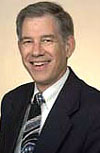CGS strives to attract top graduate
students
by Mary
Helen YarboroughPublic Relations
Competing with other top universities for the best possible candidates is the mission of Perry V. Halushka, M.D., Ph.D., dean of MUSC’s College of Graduate Studies (CGS).
In his outlook for the coming year, Halushka also said that the college intends to highlight the many accomplishments among the 304 students, but also recruit the best students in the country.
 Dr. Perry Halushka
Dr. Perry HalushkaThough MUSC’s reputation is growing, it still must catch up with the more publicized institutions in the country despite its many extraordinary accomplishments.
“We have to rely on publicizing our academic accomplishments, research, student achievements and faculty through venues that include electronic media, presentations at national and international meetings, attendance at graduate fairs and distribution of recruitment CDs,” Halushka said. “When our graduates go out and become successful, they become our greatest ambassadors. When they’re successful, then we’re successful.”
But recruiting students also means having grants and funds to help entice them.
“My number one goal is to recruit the best possible students we can,” Halushka said. “We will do this, in part, by attracting the best students in the country who surf the Web looking for a school that has extramurally-funded training grants.”
“These grants are very competitive,” Halushka said. “The College of Graduate Studies now has 14. In 2000, we had one.”
To be awarded these grants, a school must have top-notch faculty and training programs for students, he said. Faculty members apply for these grants, the largest of which come from the National Institutes of Health, U.S. Department of Education and the National Science Foundation.
CGS students are somewhat unique on campus, in that they represent a diverse set of disciplines. They also represent research involving many of the colleges. “The students are doing a lot of studies that could involve a number of programs,” Halushka said. “We have faculty whose primary appointment is in another college and their secondary appointment is in this college.”
The quality of CGS's student pool has steadily improved since 2000, Halushka said.
“We want to continue to do all that we can to ensure that we attract the highest quality students,” he said.
While recruitment is key, federal funding for research is critical.
“A second challenge is the decreasing NIH budget that has scared students away from a research career,” Halushka said.
In highlighting a concern for some students, the average age of someone getting their first NIH grant is now 42 years old. “The average age was 34 several years ago. That’s scary,” he said. “Who do you know can afford to wait until they’re 42 before they get their first research grant? This problem will almost certainly continue through the current administration. That’s pretty discouraging.”
Meanwhile, the scientific and lay communities must pressure Congress to increase health, science and educational research funding.
“We’re in a crisis. The NIH is in trouble. …The public looks to us for answers on how to cure diseases,” Halushka said. “Academics are where targets for new drugs are discovered. If funding for research in academia is reduced then the likelihood of finding new targets for drugs will be decreased.”
Along with Kathleen Brady, M.D., Ph.D., Halushka is leading MUSC’s efforts to ultimately obtain a Clinical and Translational Science Award (CTSA), which he said could also suffer under the NIH funding cuts.
“CTSA is part of the NIH road map initiative, but NIH didn’t put any extra money into it. CTSAs will require a redistribution of money from the various institutes at NIH. In spite of these challenges, the key word is ‘perseverance,’” Halushka said. “We shall persevere.”
The College of Graduate Studies’ enrollment breakdown is as follows:
Program Number of students enrolled
Master of Science 15
Master of Science/Clinical Research 36
PhD 171
MD/PhD 50
DMD/PhD 5
PharmD/PhD 1
College of Nursing/PhD 26
Total enrolled: 304 students
Friday, Sept. 29, 2006
Catalyst Online is published weekly,
updated
as needed and improved from time to time by the MUSC Office of Public
Relations
for the faculty, employees and students of the Medical University of
South
Carolina. Catalyst Online editor, Kim Draughn, can be reached at
792-4107
or by email, catalyst@musc.edu. Editorial copy can be submitted to
Catalyst
Online and to The Catalyst in print by fax, 792-6723, or by email to
catalyst@musc.edu. To place an ad in The Catalyst hardcopy, call Island
Publications at 849-1778, ext. 201.